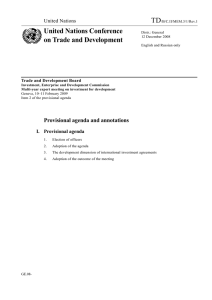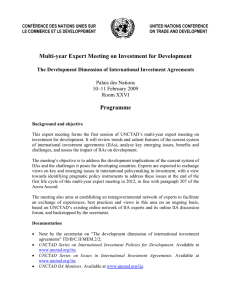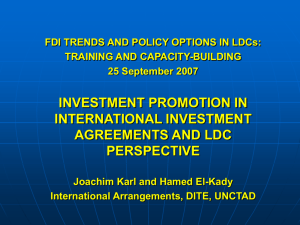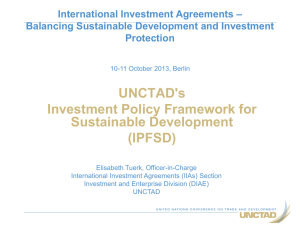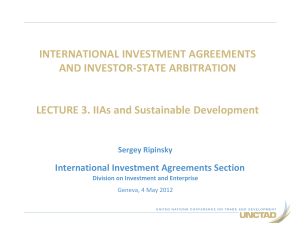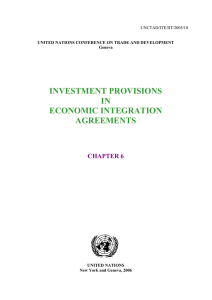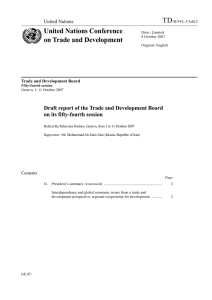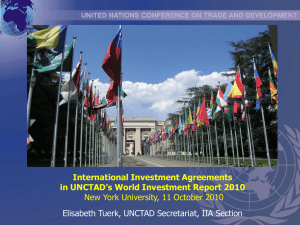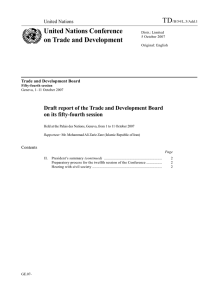TD United Nations Conference
advertisement
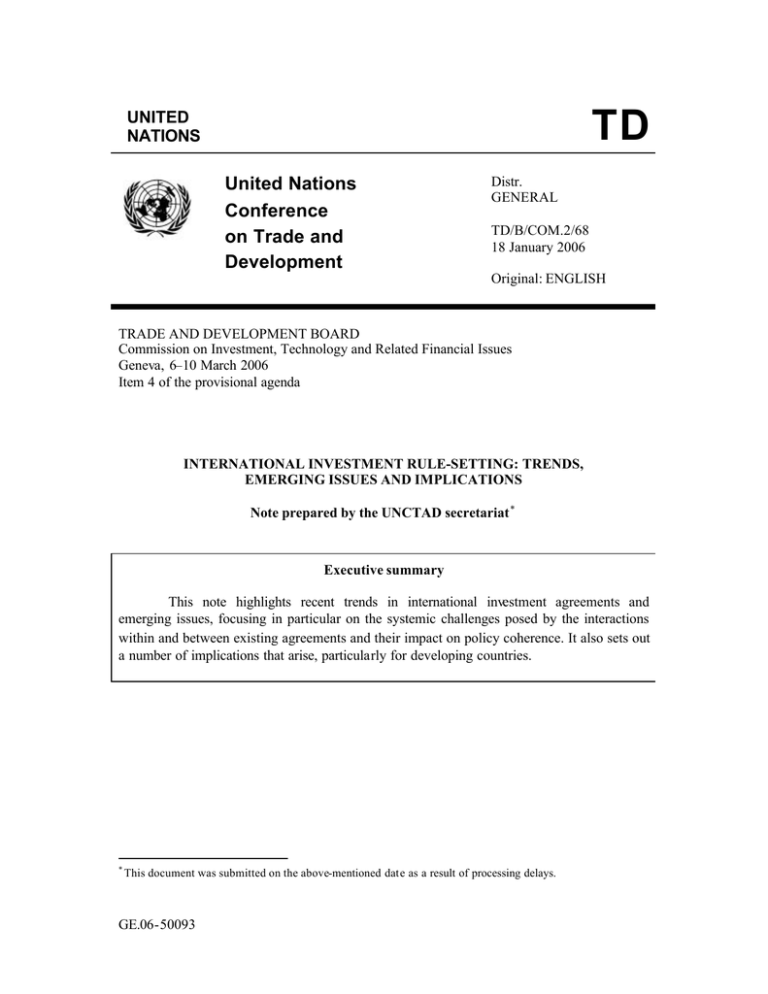
TD UNITED NATIONS United Nations Conference on Trade and Development Distr. GENERAL TD/B/COM.2/68 18 January 2006 Original: ENGLISH TRADE AND DEVELOPMENT BOARD Commission on Investment, Technology and Related Financial Issues Geneva, 6–10 March 2006 Item 4 of the provisional agenda INTERNATIONAL INVESTMENT RULE-SETTING: TRENDS, EMERGING ISSUES AND IMPLICATIONS Note prepared by the UNCTAD secretariat ∗ Executive summary This note highlights recent trends in international investment agreements and emerging issues, focusing in particular on the systemic challenges posed by the interactions within and between existing agreements and their impact on policy coherence. It also sets out a number of implications that arise, particularly for developing countries. ∗ This document was submitted on the above-mentioned date as a result of processing delays. GE.06-50093 TD/B/COM.2/68 page 2 CONTENTS Chapter Page Introduction...................................................................................................................... 3 I. Recent trends in international investment agreements ..................................................... A. Bilateral investment treaties ................................................................................... B. Double taxation treaties.......................................................................................... C. Other international investment agreements ............................................................ D. International investment disputes ........................................................................... 4 4 6 7 9 II. Systemic issues ................................................................................................................. A. Interactions among provisions within IIAs ............................................................ 1. Explication interactions ...................................................................................... 2. Cumulation interactions ...................................................................................... 3. Contradiction interactions................................................................................... 4. Amplification interactions .................................................................................. B. Interactions with other IIAs .................................................................................... 1. Reinforcement interactions ................................................................................. 2. Cumulation interactions ...................................................................................... 3. Contradiction interactions................................................................................... C. Interactions with State contracts ............................................................................. D. Addressing systemic inconsistencie s and coherence.............................................. 9 10 10 10 10 11 11 11 12 12 12 13 III. Implications...................................................................................................................... 13 A. General implications ............................................................................................... 13 B. Challenges for developing countries....................................................................... 14 References ........................................................................................................................ 16 Figures 1. 2. 3. 4. Number of BITs concluded, cumulative, 1990–2004...................................................... Total number of BITs concluded, as of end 2004, by country group .............................. Number of DTTs concluded, cumulative and year-by-year, 1990–2004......................... The growth of international investment agreements other than BITs and DTTs, 1957 – June 2005.............................................................................................................. 4 5 7 8 TD/B/COM.2/68 page 3 INTRODUCTION 1. The past decade has seen a proliferation of international investment agreements (IIAs) at the bilateral, regional and interregional levels. Last year, more than three such agreements were signed every week. Several developments are worth noting in this context. First, the universe of IIAs, consisting of bilateral investment treaties (BITs), double taxation treaties and other investment agreements, has continued to expand. Second, a new generation of IIAs is emerging with provisions that tend to be increasingly sophisticated and complex in content, clarifying in greater detail the meaning of certain standard clauses and covering a broader range of issues. Third, economic development policy is becoming more complicated by the web of overlapping commitments arising from IIAs containing a variety of provisions applicable to the same matters. At the same time, a number of agreements are not being implemented – that is, they are either not ratified by national parliaments or are not properly acted upon by the relevant authorities. Furthermore, investment treatie s have a limited duration and, given the evolution of international law on investment, several countries are embarking on the renegotiation of existing treaties. Also, the growing activity in international investment treaty making has been paralleled by a rise in investor–State disputes. The corresponding increase in interpretations of certain treaty provisions by arbitral tribunals has added to complications in this regard. As a result of these developments, countries – and companies – have to operate within an increasingly complicated framework of multilayered and multifaceted investment rules, which may contain overlapping obligations and commitments. 2. This presents new challenges for policymakers. As global economic integration becomes ever deeper, managing the impacts of integration on the domestic economy becomes more complex and the challenges involved in concluding IIAs correspondingly greater. One of the main issues in this context relates to maintaining the coherence of a country’s economic development policy. 3. Several issues arise as countries seek to ensure policy coherence in the face of a complex network of overlapping IIA provisions. In general, provisions of IIAs may interact in any of at least five different ways. First, they may interact in such a way as to create and define a particular right or duty, an “explication” interaction. Second, separate IIA provisions may create or enforce the same right or duty, a “reinforcement” interaction. Third, they may create different rights or duties applicable to the same subject matter, a “cumulation” interaction. Fourth, one provision may limit, diminish or extinguish the rights or duties created by another provision, a “contradiction” interaction. Finally, one provision may increase the impact of a right or duty created by another provision, an “amplification” interaction. 4. The following discussion highlights the recent trends in IIAs and emerging issues; it then describes some of the most common interactions in existing IIAs and identifies systemic challenges with regard to maintaining policy coherence. This is followed by a look at the implications of the ever-increasing complexity of the international investment system, particularly for developing countries. TD/B/COM.2/68 page 4 I. RECENT TRENDS IN INTERNATIONAL INVESTMENT AGREEMENTS A. Bilateral investment treaties 5. The universe of BITs continued to expand over the past year, albeit at a slower pace. During 2004, 73 new BITs were concluded, 10 of which replaced earlier BITs; this brought the total number of BITs to 2,392 (figure 1). This represents, however, a slowdown in the conclusion of BITs since 2001. Two out of five BITs were signed between developed and developing countries, and one fourth were concluded between developing economies (figure 2). BITs are usually not concluded between developed economies as investment relations between these countries are traditionally governed by other international instruments, such as the OECD Code of Liberalisation of Capital Movements, or because the protection afforded by the host country's legislation is regarded as sufficient. While developed countries still predominate in the list of the economies with the largest number of BITs, developing countries have recently intensified their efforts in this regard, including especially in the South–South context, and this has resulted in a rapid increase in the number of South–South BITs. Figure 1. Number of BITs concluded, cumulative, 1990–2004 (Numbers) 3000 2500 2000 1500 1000 500 Source: UNCTAD (www.unctad.org/iia). 20 04 20 02 200 3 20 00 200 1 19 97 19 98 199 9 19 95 199 6 19 93 199 4 199 0 19 91 199 2 0 TD/B/COM.2/68 page 5 Figure 2. Total number of BITs concluded, as of end 2004, by country group (Percentage) 4% 13% 25% 8% 10% 40% Between developing countries Between developed and developing countries Between developing countries and countries of SEE & CIS Between developed countries Between developed and countries of SEE & CIS Between countries of SEE & CIS Source: UNCTAD (www.unctad.org/iia). 6. Within the group of South–South BITs, China, Egypt, the Republic of Korea and Malaysia have each signed more tha n 40 BITs with other developing countries. In fact, each of these four countries has signed more agreements with other developing countries than with developed countries. The increase in developing countries' BITs reflects a greater emphasis in recent deve lopment strategies on South–South cooperation in respect of investment, as well as the emergence of some developing countries firms as global players (UNCTAD, 2005a). 7. BITs traditionally cover the following key issues: scope and definition of investment; admission and establishment; national treatment; most-favoured-nation treatment; fair and equitable treatment; compensation in the event of expropriation or damage to the investment; guarantees of free transfers of funds; and dispute settlement mechanisms, both State–State and investor–State (UNCTAD, 1998). Most recently, a new generation of BITs is gradually emerging that expands on their content and scope. This new generation of BITs follows the trend set by some of the recent trade agreements that include investment chapters and is exemplified by the new model BITs of the United States and Canada, all of which have important new features. Several Latin American countries have also embarked on this new generation of treaties in their negotiations with other countries (UNCTAD, forthcoming, a). 8. Within this normative evolution – which to a great extent is the result of experience in the application and implementation of the investment chapter of the North American Free Trade Agreement (NAFTA) – it is possible to distinguish four main trends. First, some new-generation BITs and BIT models have deviated from the traditional open-ended assetbased definition of "investment", attempting to find ways to strike a balance between maintaining a comprehensive investment definition and yet not including assets that are not intended by the parties to be covered investments. Second, revisions to the wording of various substantive treaty obligations are emerging that aim to elaborate upon the language and clarify the meaning of provisions dealing with absolute standards of protection, in particular the meaning of the "fair and equitable treatment" standard and the concept of indirect expropriation. Third, a broader set of issues is addressed, including not only specific TD/B/COM.2/68 page 6 economic aspects, such as investment in financial services, but also issues where more room for host country regulation is sought, for example as regards the protection of health, safety, the environment and the promotion of internationally recognized labour rig hts. Fourth, significant innovations regarding investor –State dispute settlement procedures are being made, in particular as far as greater and substantial transparency in arbitral proceedings (e.g. open hearings, publication of related legal documents) is concerned. 9. Another significant trend regarding BITs is that countries are increasingly embarking on the renegotiation of their existing treaties, as these reach their expiration date, or because of changed circumstances. While BITs generally provide for tacit renewal after their expiration, in some cases countries embark on their renegotiation, usually agreeing to greater commitments. In such cases, the new BIT either supersedes or substantially amends the earlier one. The renegotiation trend accelerated in the late 1990s and continued in subsequent years: 34 BITs had been renegotiated by the year 2000, and by 2004 the accumulated total of renegotiated BITs stood at 85. 10. During 2004, 78 BITs entered into force, and this brought the total number of BITs in force to over 1,718 (according to available information) (UNCTAD, 2005b). Hence, about 30 per cent of the total BITs signed had not yet been ratified and, consequently, had not entered into force at the end of 2004. The formal requirements for the ratification process of BITs vary from country to country according to the constitution and legislative procedures. In some countries, for example, the ratification of a treaty may require the enactment of implementing legislation, which in turn may require major adaptations of relevant legislation. However, the signing of a BIT (even if it did not enter into force) still has some legal implications for the protection and promotion of foreign investments. Ratification is, however, only the first step in implementing a treaty. It has to be followed by the actual implementation of the provisions of a treaty, including ensuring coherence between treaty commitments and national policies and strategies, as well as adequately informing the main beneficiaries of treaties, namely the foreign investors, and the local authorities that actually have to apply the treaty. Many developing economies are lagging behind in these implementation steps, and this leads at times to costly disputes and other effects that run counter to the purposes of entering into international commitments. B. Double taxation treaties 11. In 2004, 84 new double taxation treaties (DTTs) were concluded between 80 countries. This represents a sustained growth in the number of DTTs, albeit at a slightly slower pace compared with 2003. Nevertheless, the total number of DTTs increased to reach 2,559 by the end of 2004 (figure 3). Unlike in the case of BITs, the top 10 economies in terms of number of DTTs signed are all developed economies. About 39 per cent of all DTTs were concluded between developed and developing countries. DTTs among developed countries accounted for 29 per cent. Another 19 per cent involved transition economies, while the remaining 13 per cent are between developing economies. 12. Insofar as developing country DTTs are concerned, a similar but less pronounced trend (as in the case of BITs) towards increasing South–South investment cooperation can be observed. After the first South–South DTT was concluded in 1948 (by Argentina and Peru), DTTs proliferated during the second half of the 1990s. During the 1990s, 156 new DTTs were signed between 69 developing countries, and the total number of treaties stood at 256 by the end of 1999. Growth persisted until 2004, with the total number of South–South DTTs rising to 345 treaties between 90 countries. TD/B/COM.2/68 page 7 Figure 3. Number of DTTs concluded, cumulative and year-by-year, 1990–2004 (Numbers) 3000 2500 2000 1500 1000 500 0 0 1 2 3 94 995 996 997 998 999 000 001 002 003 004 199 199 199 199 19 1 1 1 1 1 2 2 2 2 2 Source: UNCTAD (www.unctad.org/iia). C. Other international investment agreements 13. Besides BITs and DTTs, international investment rules are increasingly being adopted as part of bilateral, regional, interregional and plurilateral agreements that address, and seek to facilitate, trade and investment transactions (UNCTAD, forthcoming, b). 1 These agreements contain, in addition to a variable range of trade liberalization and promotion provisions, commitments to liberalize, protect and/or promote investment flows between the parties. The number of these agreements has been growing steadily and, by June 2005, exceeded 215 (209 at the end of 2004). The large majority of these agreements, about 87 per cent have been concluded since the 1990s (figure 4). The proliferation of these agreements is one of the key developments in international economic relations in recent years in response to the increasing global competition facing national economies for resources and markets. Of course, the choice of agreement partners within and between regions results from not only a variety of economic and political motivations, but also the characteristics of the countries involved. 14. As noted earlier, one of the main objectives of these agreements is to facilitate trade and investment flows. To achieve this goal, their investment provisions focus primarily on liberalizing investment flows and, to a lesser extent, on protecting and promoting investment. They also often address investment-related issues such as intellectual property protection and competition. Thus, compared with BITs, these agreements show far more variation in the ir scope, approach and content, although some recent ones address relatively few investment issues. Moreover, recent agreements increasingly tend to encompass a broader range of economic transactions, including notably trade in goods and services, investme nt and capital, and labour. The approach of an agreement to investment issues, however, does not necessarily parallel its approach to trade or other issues. Thus, the more issues they address, the more complex the agreements and the greater the likelihood that their texts reflect the 1 These agreements can have various names, including "free trade agreement", "regional trade agreement", "economic partnership agreement", "economic integration agreement", "new-age partnership agreement", "economic complementation agreement", "agreement for establishing a free trade area" or "closer economic partnership arrangement". TD/B/COM.2/68 page 8 special circumstances of countries at different levels of economic development and in different regions. Figure 4. The growth of international investment agreements other than BITs and DTTs, 1957 – June 2005 (Numbers) 200 150 100 50 Number of PTIAs 250 0 1957-1979 1980-1989 Absolute numbers 1990-1999 2000-2005 Cumulative Source: UNCTAD (www.unctad.org/iia). Note: PTIAs = preferential trade and investment agreements. 15. As in the case of BITs, the structure and approach to investment in these recent treaties have been influenced by previous investment agreements, notably the BITs themselves and WTO agreements, and build upon the experience gained with the application of their predecessors. As a result, a number of patterns have emerged concerning their investment provisions, albeit with many significant variations: • Agreements geared to investment liberalization typically follow two main approaches. One is exemplified by NAFTA and provides for actual liberalization subject to a list of country exceptions (negative list approach). The other (exemplified by several European Union agreements with third countries) is to provide for the progressive abolition of restrictions on the entry, establishment and operation of investment. • Agreements that provide for investment protection and liberalization (concluded by a small group of countries that includes Chile, Japan, Singapore, Mexico, Morocco and the United States) follow the NAFTA model, but are more comprehensive (i.e. they cover more sectors), detailed (i.e. they provide greater sophistication) and, for the most part, more rigorous than prior NAFTA-style investment agreements. • Other recent agreements have been narrower in their coverage of investment issues, establishing only a framework for cooperation on promotion of investments (e.g. the free trade agreements signed between the countries of the European Free Trade Association and Central European countries). 16. In short, while it is possible to identify a number of patterns with respect to the content and structure of the main investment components of recent agreements, even similar types of agreements exhibit important differences. New agreements are emerging, featuring a structure and approach to investment issues not found in earlier agreements. In many cases, TD/B/COM.2/68 page 9 the differences result from a need to correct some deficiencies detected in the application of previous agreements. Thus, the elaboration of investment rules through these other investment agreements is advancing through a process that builds on previous experience while experimenting with innovative approaches to address new challenges. At the same time, the interactions among an expansive set of rules within an agreement addressing investment as well as other economic transactions, gives rise to the risk of ove rlaps and inconsistencies. This complicates the task of gauging the full legal and policy implications of any such agreement and increases the risk of investment disputes. D. International investment disputes 17. The bilateral and regional initiatives described above are meant to increase investors’ confidence in the reliability of the legal and regulatory framework. An important pillar of this equation has been the provision on investor –State dispute settlement. This provision is increasingly being used by in vestors, with serious development implications. The cumulative number of treaty-based cases brought before the World Bank Group's International Centre for Settlement of Investment Disputes (ICSID) and other arbitration forums has been rising enormously ove r the past five years, reaching at least 219 known claims by November 2005. 2 This development poses a particular challenge for developing countries. At least 61 Governments – 37 of them in the developing world, 14 in developed countries and 10 in South-East Europe and the Commonwealth of Independent States – have faced investment treaty arbitration (UNCTAD, forthcoming, c). 18. Investment disputes cover the whole range of investment activities, relate to all kinds of investments (including privatization contracts and State concessions), apply to a diversity of industries and activities and can have substantial financial implications, from the point of view of both the costs of the arbitration proceedings and the awards rendered. The surge in investment disputes arising from IIAs, and the costs incurred as a result of these disputes, signify that Governments that decide to enter into IIAs need to be judicious in negotiating such agreements. They also need to follow the developments of disputes in order to be sensitive to actions that could trigger litigation. Furthermore, it is important to review experiences in implementing international commitments in IIAs and to draw lessons therefrom. II. SYSTEMIC ISSUES 19. The interactions between provisions within an IIA and between IIAs may undermine policy coherence. Policy coherence, in general, requires that the provisions of a country’s IIAs be consistent with the country’s investment policy. In particular, the IIAs should not be significantly over-inclusive (i.e. they go further than the underlying policy requires) or significantly under-inclusive (i.e. they do not go as far as the underlying policy requires). Policy coherence also requires that a country’s IIAs be consistent with each other. Not only should it be possible for a party to comply with all applicable IIA provisions, but also 2 Under several arbitration systems, the existence of a dispute and its final outcome are never made public. Even under the ICSID arbitration system, the decisions of the tribunals have not all been made public. While this situation is gradually changing, it means that it is not possible to know the actual number of cases to date, nor is it possible to learn about all the legal issues or factual circumstances they encompassed. The ICSID arbitration facility is the only facility that maintains a public registry of claims. A number of claims are known to be proceeding outside ICSID, however. TD/B/COM.2/68 page 10 compliance with one IIA provision should not impair furtherance of the policy underlying another IIA provision. Several issues need to be considered in this context. 3 A. Interactions amo ng provisions within IIAs 1. Explication interactions 20. The most common interaction among provisions within an IIA is the explication interaction. In any IIA, the definitions provisions, exceptions provisions, substantive provisions and dispute resolution provisions all interact in ways to establish the overall impact of the agreement. For example, the expropriation provision found in many IIAs requires payment of compensation for the expropriation of investment, but the nature of the assets protected by this provision typically can be identified only with reference to the definition of the term “investment”. The greatest challenge to consistency presented by this interaction may arise from the complexity of the agreement. The larger the number of provisions involved in the interaction, the greater the likelihood that the negotiators will not be able to anticipate all the consequences of the interaction. 2. Cumulation interactions 21. An increasingly common interaction in new generation IIAs, as they become more comprehensive, is the cumulation interaction. One situation where the potential for inconsistency is clear in such an interaction may be found in agreements that have a chapter on investment and a separate chapter on trade in services. Investment chapters sometimes have provisions on establishment utilizing a negative list approach, while services chapters sometimes have provisions on market access utilizing a positive list approach. Another situation occurs in agreements that have a chapter on trade in services generally and additional chapters on trade in certain service sectors, such as financial services. 22. A cumulation interaction may occur not only with respect to substantive provisions in the same agreement, but also with respect to dispute resolution provisions. For example, some IIAs include an investment chapter with an investor–State resolution mechanism that is cumulative to the more general dispute resolution mechanism in the agreement. The issue may arise as to whether disputes concerning other chapters of the agreement may be brought under the investor–State dispute resolution mechanism. 3. Contradiction interactions 23. In IIAs, a conflict may arise between the objective of the home country of foreign direct investment (FDI), namely to achieve a maximum level of investment liberalization and protection, and the interests of the FDI host country, namely to emphasize the development dimension of the agreement and keep sufficient policy space in this respect. The tension this creates is obvious. Too much policy space impairs the value of international obligations. Too stringent obligations overly constrain national policy space. Finding a development-oriented balance within the objectives, structure, implementation and content of IIAs remains a challenge . 24. Of particular importance from a development perspective may be the use of performance requirements, incentives, transfer-of-technology policies and competition policy, because they can advance development objectives. For each of these issues, more 3 For a more in-depth analysis of the following, see U NCTAD/APEC (2005). TD/B/COM.2/68 page 11 development-friendly and less development-friendly solutions exist. However, up to now only a minority of IIAs deals with them explicitly. In the absence of specific provisions, the IIA core principle of non-discrimination may prohibit developing countries from imposing special obligations on foreign investors only. 4. Amplification interactions 25. Provisions of an IIA sometimes amplify the impact of other provisions within the same IIA – that is, there are amplification interactions. For example, a host country that concludes an IIA with a chapter on trade in services may commit itself to granting market access to service providers in a particular sector of the economy. Once a service provider has established a commercial presence in the host country in accordance with the market access commitment, the commercial presence may also be considered an investment within the meaning of the investment chapter and, therefore, entitled to all of the protections afforded to investment generally. B. Interactions with other IIAs 1. Reinforcement interactions 26. Provisions of different IIAs very often have reinforcement interactions. Several different approaches may be found in existing agreements. IIAs sometimes include provisions in which the parties reaffirm commitments under other treaties to which they are already parties. This occurs, for example, in services-related provisions in which parties reaffirm their commitments under the General Agreement on Trade in Services (GATS). IIAs also sometimes require the parties to observe obligations under another agreement. Examples include various IIAs requiring the parties to abide by the WTO’s Agreement on TradeRelated Investment Measures. Furthermore, IIAs may incorporate obligations under other agreements. The effect of a provision in an IIA requiring the parties to observe another agreement could well make a violation of the other agreement a violation of the IIA. This in turn could permit submission of a dispute involving an alleged violation of the other agreement to the dispute resolution mechanism of the IIA, again leading to the possibility of parallel dispute resolution proceedings. 27. One very common provision in IIAs that can serve, in effect, to incorporate the provisions of numerous other treaties is the most-favoured-nation (MFN) clause, which requires the host country to provide covered investment with treatment no less favourable than that provided to any other foreign investment. Depending on how the MFN clause is drafted, the host country may be obligated under the IIA to honour, with respect to covered investments, commitments made with respect to foreign investment in any other agreements. 28. In some respects, incorporation under an MFN clause may be slightly narrower than incorporation under a more explicit incorporation provision. First, MFN clauses usually require not identical treatment, but treatment “no less favourable” than that provided to another foreign investment, thus allowing the host State to offer different treatment as long as it is not less favourable. Second, MFN clauses apply only to investments “in like situations,” allowing the host State to disregard the commitments made under another IIA if the covered investment is in a situation unlike that of investments covered by the other IIA. 29. In other respects, however, the incorporation under an MFN clause is far broader than that under any other reinforcement interaction. An MFN clause incorporates not merely TD/B/COM.2/68 page 12 the obligations under a specified other IIA, but also those under every other agreement that a party has concluded. It also incorporates obligations under agreements that a party concludes in the future. Commitments made under other agreements, of course, are made as part of an overall balance of obligations assumed and rights granted. An MFN clause, however, incorporates the party’s commitments under other agreements unaccompanied by the rights for which those commitments were exchanged ("free rider" issue). The risk is that commitments incorporated outside the context in which they were originally made may result in over-inclusiveness. 4 2. Cumulation interactions 30. Often, there are cumulation interactions between provisions of different IIAs. For example, most IIAs apply to investments that are a means of providing cross-border services and such investments would also be governed by the GATS, to the extent that the investments could be described as constituting a commercial presence in the host State. 31. Cumulation interactions between different IIAs can also involve procedural provisions. This is particularly true where services provisions in an IIA create obligations similar to those under the GATS and that may therefore give rise to disputes that could fall within both the WTO dispute resolution mechanism and the IIA dispute resolution mechanism. 32. Whether they involve provisions of the same agreement or of different agreements, multiple dispute resolution proceedings can greatly threaten consistency. First and foremost, they can produce interpretations of the agreements that are inconsistent. Even where the results are consistent, the expenditure of resources involved in redundant resolutions of the same claim may be considerable. 3. Contradiction interactions 33. Occasionally, provisions of different IIAs are in a contradiction interaction. For instance, while a BIT may grant a right of establishment to foreign investors, a regional agreement to which a party to the bilateral agreement belongs may exclude such a right. Similarly, different treaties may contain different provisions and/or language concerning performance requirements and other substantive issues dealing with the treatment of foreign investment once admitted. C. Interactions with State contracts 34. Interactions may also occur between the provisions of an IIA and the provisions of a contract between the host country and the investor (i.e. a State contract), such as an investment authorization (UNCTAD, 2004b). In some cases, the interaction is a reinforcement interaction. This occurs, for example, where the IIA has a so-called umbrella clause, which requires the host country to observe obligations into which it has entered with respect to an investment. Under this clause, a violation of the State contract also violates the IIA. If the State contract includes a choice of forum clause specifying that disputes shall be resolved in a particular form, the investor may seek to submit the dispute both to that forum and to any forum provided by the IIA, such as an investor–State dispute resolution mechanism. 4 This risk is, however, reciprocal – that is, both parties to the IIA may benefit from a "free rider" situation. See, in this context, UNCTAD (2004a). TD/B/COM.2/68 page 13 35. Provisions of IIAs may sometimes have contradiction interactions with provisions of State contracts. For example, IIA prohibitions on performance requirements may limit the host country’s ability to include certain requirements in a State contract. Similarly, IIA provisions on non-discrimination might limit the ability of the host country to guarantee preferential treatment to a particular investor in a State contract. D. Addressing systemic inconsistencies and coherence 36. Because of the potential for IIA provisions to undermine policy coherence, some IIAs have adopted a number of solutions intended to maintain policy coherence in the face of overlapping IIA provisions. At least five different solutions can be identified in existing agreements. 37. The “definition” solution defines the terms of a provision in such a way as to eliminate any inconsistency with corresponding provisions in other IIAs. However, this solution implies that different IIAs use almost identical definitions of a term (e.g. the definition of "investment"). Such an outcome might be difficult to achie ve. The same concern, albeit to a lesser extent, exists with regard to the “scope” solution, which limits the scope of a provision so as to avoid inconsistency with another corresponding provision (e.g. the geographical and temporal application of a treaty). The “hierarchy” solution specifies which provision shall prevail in the event of an inconsistency. This approach is reflected in the Vienna Convention on the Law of Treaties, which provides that the later agreement prevails as among the parties to both agreements. A systemic problem could therefore arise if a party to these contradictory agreements is not a party to the Vienna Convention. The “election” solution allows a specified actor to choose which provision shall prevail in the event of an inconsistency. This solution is very rare and comes close to dispute settlement procedures. Finally, the “agreement” solution specifies that any inconsistency shall be resolved by agreement of the parties. It leaves open the question of what should happen if the parties do not reach agreement. III. IMPLICATIONS A. General implications 38. The number of IIAs has increased enormously since 1990. This has resulted in an increasingly complicated framework of multilayered and multifaceted investment rules. On the one hand, this system of international investment rules contributes to the predictability, transparency and stability of international investment relations, which forms a crucial ingredient of the enabling framework for attracting FDI and benefiting from it. On the other hand, the current approaches at the bilateral and regional levels increase the complexity of the international investment rule system, and this results in the risk of overlapping and inconsistent obligations. 39. A number of implications arise that need to be addressed in the process of future international investment rule setting. • First, the complexity of negotiations increases as more and more countries, and more and more issues, are involved. This raises the questions of how broad the agenda of any particular set of negotiations should be, and how ambitious parties want to be concerning the nature of commitments. TD/B/COM.2/68 page 14 • Second, the negotiation of IIAs includes interrelated, difficult policy issues that at least in principle touch upon a whole range of domestic concerns, comprising, increasingly, social and environmental matters. Indeed, such agreements reflect the growing internationalization of the domestic policy agenda. Failure to take related issues of national policy properly into consideration may have serious development implications for the host countries. Therefore, IIAs should reflect a certain balance between rights and responsibilities – either by including them within the same instrument or by establishing bridges with other binding and non-bindin g international instruments. • Third, although IIAs by definition contain obligations that, by their very nature, limit to some extent the autonomy of participating parties, the need for a certain degree of flexibility to allow countries to pursue their development objectives in the light of their specific needs and circumstances should be addressed. The more investment agreements go beyond promotion and protection issues and in particular attempt to include commitments to liberalize, the more complicated their negotiation becomes. Where liberalization is sought, progressive liberalization of investment regulations may be more acceptable than upfront and all-embracing commitments to liberalize. • Fourth, transparency in the conduct of investment negotiations plays a key role in securing the necessary support and legitimacy for international investment agreements. The awareness, understanding and input of all development stakeholders are important. B. Challenges for developing countries 40. While the above issues are important to all countries at whatever level of development, developed, developing and transitional alike, they are more pertinent for developing countries that have less capacity to deal with them. In particular, developing countries are faced with four challenges in this regard: • First, developing countries need to ascertain how best to integrate IIAs into their economic development policy. These agreements are intended to promote economic development by providing a stable, predictable and transparent environment for foreign investment. However, all international agreements circumscribe the discretion of the parties. Developing countries need to retain sufficient policy space to promote economic development, without undermining the effectiveness of the IIA. • Second, developing countries need to establish and maintain policy coherence in the face of a large number of interacting IIAs. As an initial matter, this entails creating a coherent national development approach that integrates investment, trade, competition, technology and industrial policies. As new IIAs are negotiated, each should be reviewed carefully to ensure that it is consistent with and, in fact, promotes the State’s economic development. Establishing and maintaining policy coherence has become more challenging for developing countries in recent years because of at least two factors. One factor is that many developing countries are now both capital-importing and capital-exporting economies. Thus, an IIA may have implications for a developing country as both host and home State. The other factor is the sheer number and complexity of the agreements. • Third, developing countries need to ensure that they have sufficient capacity to analyse the scope of obligations into which they are entering when they conclude an IIA. They also need to improve their capacities to understand the economic and social implications of the commitments contained in IIAs. TD/B/COM.2/68 page 15 • Fourth, developing countries need to implement the treaty commitments they have assumed. Implementation entails completing the ratification process, bringing national laws and practices into conformity with treaty commitments, informing and training local authorities that actually have to apply the IIA, managing the disputes that arise under IIAs, and re-evaluating national investment policies in the light of national development strategies and past experience. 41. Finding a development-oriented balance in future IIAs that adequately addresses these issues remains a challenge. In the pursuit of the development dimension of IIAs, more attention also needs to be paid to commitments by home countries and to the contributions that TNCs can make to advance the development impact of their investment in developing countries (UNCTAD, 2005c, 2001a and 2001b). As already noted, the burden of addressing these challenges is likely to weigh disproportionately on developing countries, especially the least developed ones, because they often lack the human and financial resources needed to implement agreements. This underlines the importance of capacity-building technical cooperation to help developing countries assess better various policy options before entering into new agreements and to help them in implementing the commitments made. International organizations can play a role in this regard. TD/B/COM.2/68 page 16 REFERENCES United Nations Conference on Trade and Development (UNCTAD) (forthcoming, a). Bilateral Investment Treaties 1995–2005: Trends in Investment Rule-making. UNCTAD Series on Issues in International Investment Polices for Development (Geneva and New York: United Nations), United Nations publication. __________ (forthcoming, b). Economic Integration Investment Agreements. UNCTAD Series on Issues in International Investment Polices for Development (Geneva and New York: United Nations), United Nations publication. __________ (forthcoming, c). Latest Developments in Investor–State dispute settlement. IIA Monitor Nr. 4 (2005), United Nations publication. __________ (2005a). South -South Cooperation in International Investment Arrangements. UNCTAD Series on Issues in International Investment Polices for Development (Geneva and New York: United Nations), United Nations publication, sales no. E.05.II.D.26. __________ (2005b). Many Bits Have Yet To Enter Into Force, IIA Monitor Nr 3 (2005), UNCTAD/WEB/ITE/IIA/2005/10, available at www.unctad.org/iia. __________ (2005c). "Report of the Expert Meeting on Positive Corporate Contributions to the Economic and Social Development of Host Developing Countries, Geneva, 31 October – 2 November 2005", forthcoming. __________ (2004a). The REIO Exception in MFN Treatment Clauses. UNCTAD Series on Issues in International Investment Polices for Development (New York and Geneva: United Nations), United Nations publication, sales no. E.05.II.D.1. __________ (2004b). State Contracts. UNCTAD Series on Issues in International Investment Agreements (New York and Geneva: United Nations), United Nations publication, sales no. E.05.II.D.5. __________ (2001a). Home Country Measures. UNCTAD Series on Issues in International Investment Agreements (N ew York and Geneva: United Nations), United Nations publication, sales no. E.01.II.D.19. __________ (2001b). Social Responsibility. UNCTAD Series on Issues in International Investment Agreeme nts (New York and Geneva: United Nations), United Nations publication, sales no. E.01.II.D.4. __________ (1998). Bilateral Investment Treaties in the Mid -1990s (New York and Geneva: United Nations), United Nations publication, sales no. E.98.II.D.8. __________ and Asia Pacific Economic Cooperation (UNCTAD and APEC) (2005). International Investment Agreements: Recent Trends and Implications (Geneva and Singapore: UNCTAD and APEC). *** ** ***
